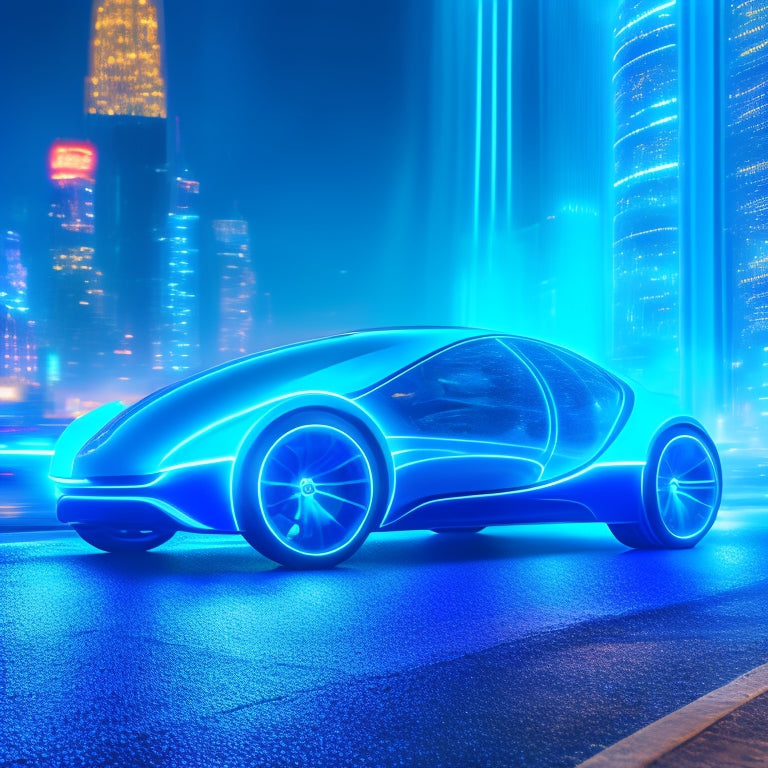
What If Your Car Became a Power Plant?
Share
As you connect your electric vehicle, its advanced battery management system optimizes energy storage, unleashing the potential for your car to become a decentralized power plant, feeding excess energy back into the grid. This two-way energy flow enables you to monetize your vehicle's energy storage capacity through energy trading platforms. By harnessing your car's power, you can reduce strain on the grid, improve air quality, and even generate revenue. As you explore the possibilities of vehicular energy trading, you'll discover the intricacies of grid stability, peak demand management, and renewable energy storage solutions, opening up new avenues for a sustainable energy future.
Key Takeaways
• Electric vehicles can act as power plants by feeding excess energy back into the grid through Vehicle-to-Grid (V2G) technology.
• This concept enables EV owners to monetize their energy storage capacity and stabilize the grid during peak demand.
• Decentralized energy trading platforms and blockchain technology facilitate secure and efficient energy trading between EV owners and the grid.
• Optimizing EV battery performance and state of charge is crucial for efficient energy trading and grid stability.
• By harnessing EV battery power, we can reduce strain on power plants, improve air quality, and enhance sustainability for a greener future.
Harnessing EV Battery Power
How do you tap into the vast energy reserves stored in electric vehicle (EV) batteries to power your car's systems? The answer lies in energy harvesting, a technique that optimizes battery performance and enables your EV to supply power to its systems efficiently. By leveraging advanced battery management systems, you can access the full potential of your EV's battery, reducing energy waste and maximizing its capacity.
To achieve this, you'll need to optimize your battery's state of charge, voltage, and temperature. This is where battery optimization comes in – a process that fine-tunes your battery's performance, ensuring it operates within its ideal parameters. By doing so, you'll be able to tap into the excess energy stored in your EV's battery, channeling it towards powering your car's systems, such as the infotainment system, lights, or even your home.
The Future of Energy Trading
As you explore the future of energy trading, you'll encounter innovative platforms that are reshaping the way energy is bought and sold.
These energy trading platforms will enable peer-to-peer transactions, allowing individuals to monetize their excess energy generation.
Meanwhile, decentralized energy networks will emerge, enabling real-time balancing of supply and demand, and optimizing energy distribution.
Energy Trading Platforms
You'll likely encounter energy trading platforms that utilize blockchain technology to create a secure, decentralized, and transparent marketplace for buying and selling excess energy.
These platforms will enable you to monetize your vehicle's energy storage capacity, allowing you to sell excess energy back to the grid or to other consumers.
As you navigate these platforms, you'll need to take into account market trends, such as fluctuating energy prices and demand. Regulatory frameworks will also play an essential role, as governments and institutions establish guidelines for energy trading.
For instance, you may need to comply with regulations around energy storage, transmission, and distribution. By understanding these factors, you'll be better equipped to navigate the complex landscape of energy trading platforms.
As you explore these platforms, you'll discover new opportunities to generate revenue and optimize your energy usage. With the rise of decentralized energy trading, you'll be at the forefront of a revolution that's transforming the way we think about energy production and consumption.
Decentralized Energy Networks
In the not-too-distant future, decentralized energy networks will empower individuals to buy and sell excess energy directly with one another, bypassing traditional intermediaries and fundamentally reshaping the energy trading landscape.
You'll be part of a community that's taking control of its energy needs. Decentralized energy networks will enable you to:
-
Produce and sell excess energy: Share your car's generated power with your neighbors or the grid.
-
Buy energy directly: Purchase energy from your community, reducing reliance on traditional power plants.
-
Participate in energy cooperatives: Join forces with your community to develop and manage local energy projects.
- Make informed energy decisions: Access real-time data to optimize your energy usage and trading strategies.
This shift towards decentralized energy networks will foster Community Engagement and Energy Democracy, where individuals have a say in their energy future.
As you navigate this new landscape, you'll be part of a movement that's redefining the way we produce, consume, and trade energy.
Two-Way Charging Technology
Your electric vehicle's advanced two-way charging technology allows it to supply power back to the grid when not in use, effectively turning it into a mobile energy storage unit. This innovative technology enables you to optimize energy efficiency by feeding excess energy back into the grid, reducing strain on the energy network during peak hours. However, with this increased connectivity comes cybersecurity risks, as your vehicle's system becomes a potential entry point for hackers.
| Feature | Description | Benefits |
|---|---|---|
| Two-way charging | Enables energy flow both to and from the grid | Increased energy efficiency, reduced strain on grid |
| Vehicle-to-Grid (V2G) | Allows vehicles to act as energy storage units | Optimized energy distribution, reduced energy waste |
| Advanced charging systems | Enables faster, more efficient charging | Reduced charging time, increased convenience |
| Cybersecurity protocols | Protects against potential hacking threats | Ensures secure energy exchange, protects user data |
As you explore the possibilities of two-way charging technology, remember to prioritize energy efficiency and cybersecurity to guarantee a seamless and secure energy exchange experience.
Vehicle to Grid Benefits
By harnessing your electric vehicle's Vehicle-to-Grid (V2G) capabilities, you can access a range of benefits that extend beyond reduced energy waste and optimized energy distribution. With V2G, your car becomes an active participant in the energy grid, providing benefits that directly impact your life and the environment.
Here are just a few advantages you can expect:
-
Increased Efficiency: By feeding energy back into the grid, you're reducing the strain on power plants, resulting in a more efficient energy system.
-
Improved Air: With V2G, you're reducing the need for fossil fuels, which means cleaner air and a healthier environment.
-
Lower Energy Costs: By selling excess energy back to the grid, you can offset your own energy costs, saving you money in the long run.
- Enhanced Sustainability: By leveraging V2G, you're contributing to a more sustainable energy ecosystem, paving the way for a greener future.
Grid Stability and Reliability
As you explore the domain of grid stability and reliability, you'll quickly realize that maintaining voltage levels is essential, as even slight deviations can have far-reaching consequences.
You'll also discover that frequency stability is key to ensuring a smooth operation, and that power quality control is vital to prevent disruptions.
Voltage Regulation Matters
Voltage regulation plays a critical role in maintaining grid stability and reliability, as it directly impacts the ability of the power plant to supply electricity within a stable voltage range. As you dive deeper into the world of car power plants, you'll realize that voltage fluctuations can have devastating effects on the grid. Efficient transmission is key to guaranteeing that the power plant operates within a stable voltage range.
Here are four key reasons why voltage regulation matters:
-
Voltage fluctuations can cause equipment damage: When voltage levels deviate from the ideal range, it can lead to equipment failure, reducing the overall efficiency of the power plant.
-
Inefficient transmission leads to energy loss: Voltage regulation helps minimize energy loss during transmission, ensuring that the power plant operates at peak levels.
-
Voltage regulation ensures consistent power supply: By maintaining a steady voltage range, you can guarantee a consistent power supply to meet the demands of your car's electrical systems.
- Ideal voltage range reduces energy waste: By operating within the ideal voltage range, you can reduce energy waste, leading to a more efficient and environmentally friendly power plant.
Frequency Stability Keys
You'll find that frequency stability is just as important as voltage regulation in maintaining grid stability and reliability, as it directly impacts the power plant's ability to synchronize with the grid's frequency.
When your car-turned-power-plant is connected to the grid, it's vital to make sure that its frequency output aligns with the grid's frequency. Any deviation can cause power oscillations, leading to grid instability. To mitigate this, your power plant must be designed to detect and respond to changes in grid frequency.
This is where grid resonance comes into play. By analyzing the grid's resonance characteristics, your power plant can adjust its frequency output to maintain synchrony with the grid. This synchronization is critical, as it prevents power oscillations that can destabilize the grid.
Power Quality Control
Your car-powered plant's grid stability and reliability hinge on effective power quality control, which involves regulating the plant's output to guarantee it meets the grid's stringent standards. This is essential, as poor power quality can lead to equipment malfunctions, premature wear, and even blackouts.
To secure seamless integration with the grid, your plant must meet specific power quality standards.
Here are some key aspects to focus on:
-
Power Factor: Maintaining a high power factor (>0.95) ensures your plant's output is in sync with the grid's voltage waveform.
-
Harmonic Distortion: Limiting harmonic distortion (<5%) prevents your plant's output from interfering with the grid's sinusoidal waveform.
-
Voltage Regulation: Keeping voltage fluctuations within ±5% ensures your plant's output is stable and reliable.
- Frequency Regulation: Maintaining a stable frequency (50/60 Hz) ensures your plant's output is synchronized with the grid.
Peak Demand Management Systems
In peak demand management systems, sophisticated algorithms and machine learning techniques are integrated to predict and manage energy consumption patterns, enabling utilities and grid operators to optimize power distribution during peak periods. You, as a car owner, will benefit from this technology as it guarantees a stable and efficient energy supply. Load forecasting, an important aspect of peak demand management, helps predict energy consumption patterns, allowing utilities to prepare for peak periods. Demand response programs, another key component, incentivize you to adjust your energy usage during peak hours, reducing the strain on the grid.
| Peak Demand Management Strategy | Benefits | Impact |
|---|---|---|
| Load Forecasting | Improved energy supply planning | Reduced energy waste |
| Demand Response | Financial incentives for energy efficiency | Decreased peak demand |
| Real-time Monitoring | Enhanced grid reliability | Increased energy efficiency |
Electric Vehicle Energy Trading
Electric vehicle energy trading enables your car to act as a power plant, feeding excess energy back into the grid and stabilizing the electrical infrastructure. As you plug in your car, you're not just charging it, you're also becoming an active participant in the energy market. Your vehicle's advanced battery technology allows it to store excess energy, which can then be sold back to the grid when demand is high. This energy trading has significant implications for the market and regulatory frameworks.
Here are 4 key aspects of electric vehicle energy trading:
-
Market Analysis: Understanding the energy market's supply and demand dynamics is essential for effective energy trading. By analyzing market trends, you can optimize your energy trading strategy and maximize your returns.
-
Regulatory Frameworks: Governments and regulatory bodies are creating frameworks to support electric vehicle energy trading. These frameworks will shape the industry's growth and development.
-
Vehicle-to-Grid (V2G) Technology: Advanced V2G technology enables seamless energy trading between your car and the grid.
- Grid Stabilization: Electric vehicle energy trading helps stabilize the grid by providing excess energy during peak demand periods, reducing the strain on the electrical infrastructure.
As you navigate the world of electric vehicle energy trading, understanding these key aspects will help you make informed decisions and stay ahead in the game.
Renewable Energy Storage Solutions
As you explore the world of electric vehicle energy trading, you'll find that renewable energy storage solutions play a significant role in stabilizing the grid and maximizing returns. These solutions enable the efficient storage of excess energy generated from renewable sources, which can then be fed back into the grid when needed. This not only reduces strain on the grid but also increases the overall efficiency of the energy system.
| Energy Storage Solution | Capacity | Cost |
|---|---|---|
| Lithium-Ion Batteries | 10 kWh | $500 |
| Flow Batteries | 50 kWh | $2,000 |
| Hydrogen Fuel Cells | 100 kWh | $5,000 |
| Sodium-Ion Batteries | 20 kWh | $1,000 |
| Lead-Acid Batteries | 5 kWh | $200 |
Smart Charging Infrastructure Needs
You'll need to upgrade your charging infrastructure to accommodate the fluctuating energy demands of electric vehicles, ensuring seamless integration with the renewable energy storage solutions discussed earlier. This upgrade is essential to support the increased electricity flow, reduce strain on the grid, and minimize infrastructure costs.
To achieve this, you'll need to take into account the following key aspects:
-
Grid Capacity: Upgrade the electrical grid to handle the increased power demand, ensuring reliable and efficient energy distribution.
-
Smart Charging Systems: Implement advanced charging systems that can manage and optimize energy flow, reducing peak demand and strain on the grid.
-
Urban Planning: Incorporate electric vehicle charging infrastructure into urban planning, ensuring convenient and accessible charging points for users.
- Data Analytics: Utilize data analytics to monitor and optimize energy distribution, predicting energy demand and adjusting the grid accordingly.
Frequently Asked Questions
Can I Sell Excess Energy Back to the Grid From My EV Battery?
You can sell excess energy back to the grid from your EV battery, leveraging energy harvesting, as many utilities allow grid parity, enabling you to offset your energy costs, and even profit from your stored energy.
How Does Vehicle-To-Grid Technology Affect My Car's Warranty?
When you enable vehicle-to-grid technology, you'll likely wonder how it affects your car's warranty. Fortunately, most manufacturers support V2G, and its impact on battery durability is minimal, ensuring your warranty remains intact, with some even providing extended coverage for V2G-enabled vehicles.
Are There Any Safety Concerns With Bidirectional Charging?
"As you venture into bidirectional charging, you'll want to wary of wicked fire hazards and cunning cyber attacks, which can compromise your car's security and spark devastating consequences - so, stay vigilant, dear driver."
Can I Use My EV as a Backup Power Source During Outages?
When outages strike, you can rely on your EV as a backup power source, boosting your emergency preparedness and contributing to grid resilience, provided you've invested in the necessary bidirectional charging infrastructure.
Will My Electricity Bill Increase With Vehicle-To-Grid Charging?
Did you know that 80% of EVs are parked for 23 hours a day? As you charge your EV, your electricity bill might increase, but with peak demand management and energy storage optimization, you'll minimize costs and optimize your vehicle-to-grid charging.
Related Posts
-

Why Choose Affordable Electric Scooters for Urban Commuting
By choosing an affordable electric scooter for urban commuting, you'll not only reduce your transportation costs by u...
-

Top Mountain Bike Electric Conversion Systems
When upgrading your mountain bike with an electric conversion system, you can choose from top brands like Mountain Tr...
-

7 Best Financial Incentives for Residential Homeowners
You're entitled to a range of financial incentives that can help offset the costs of owning a home, from federal tax ...


